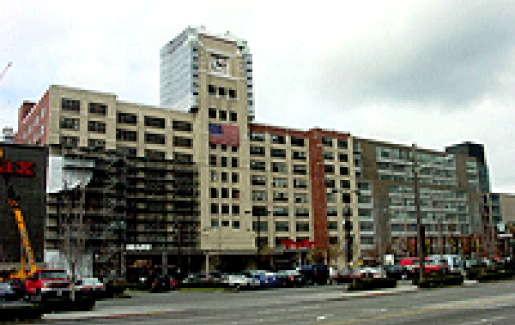Earthquake Damages Starbucks Building
A magnitude 6.8 earthquake, called Nisqually in seismic circles, rocked Seattle, Washington, in 2001 and severely damaged the Starbucks corporate headquarters building.
…We greatly appreciate your professionalism, knowledge, and experience, that have assisted us in the preparation of the claim and through our recent negotiations with the insurance carriers. … The team you assembled brought extensive experience to the table during a time when it was critical. Without this experience, we would not have been able to make it through the catastrophe in the manner we did.
I would never hope for a similar situation, but if misfortune struck us again, we would not hesitate in hiring your firm to assist us to prepare and negotiate the insurance claim.
Description
The 1,850,000-square-foot facility is a vintage 1910-1926 building, constructed by poured-in-place concrete with URM (unreinforced masonry) infill walls, which are known, in this day and age, to be prone to failure when faced with an earthquake or high wind pressure. Fortunately, about a year before the earthquake, the building had been seismically retrofitted.
Adjusters International was hired by the building owners, Nitze-Stagen & Co., Inc., to address, among the many issues, the position taken by the insurance carriers that the building was old and the damage pre-existed the magnitude 6.8 earthquake.
Issues
- The insurance carriers’ consultants took the position that most of the cracks had occurred before the earthquake.
- The insurance carriers’ consultants prepared a repair proposal that was based upon the installation of Heli pins into the URM infill walls.
- The carriers argued that although the slabs were cracked as a result of the earthquake, the cracks did not affect the performance of the slabs.
- The carriers refused to pay out for the projected cost of repairs before the repairs were effectuated.
Solutions Applied
Adjusters International assembled a team of engineers to prepare a dynamic analysis and presentation that cited petrographic analyses demonstrating that Nisqually had indeed caused the cracks.
Adjusters International’s team of engineers proved that the carriers’ proposal to use Heli pins to repair damaged walls would result in additional and more severe damage to the URM infill walls in the event of another magnitude 6.8 earthquake. Such a repair, Adjusters International’s experts additionally pointed out, was not in compliance with FEMA guidelines.
Our team, which included attorneys, researched the legality of the insurance carriers’ position that coverage applied only to actual repairs. Adjusters International was able to prove that the carriers’ position would not stand up and would be impossible to defend in a court of law. Ultimately, the insurers agreed.
Outcome
Adjusters International’s team of professionals created a body of legal and technical evidence that clearly demonstrated the effects of the large earthquake on the building. The evidence also shed light on the scope of damage another earthquake could cause if the course of repairs was not properly directed. With the help of Adjusters International, the building owners were able to make repairs in the manner they felt would best protect their assets for the future.

